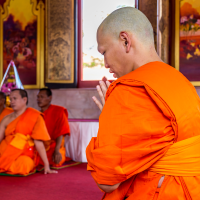Buddhist Counseling Therapy
Description
Buddhist-based Counseling Therapy draws on Buddhist philosophy and practices to support individuals dealing with mental and emotional challenges such as emotional instability, major depression, social anxiety disorders, post-traumatic stress disorder and autism spectrum disorder. This approach offers unique insights and tools by integrating mindfulness, meditation, and Buddhist teachings with modern therapeutic techniques. Here’s an overview of how Buddhist principles can be applied to enhance therapy for these conditions, offer a holistic approach to mental and emotional well-being. Offering valuable insights and tools that complement traditional therapeutic techniques. It can provide individuals with meaningful pathways to reducing suffering and achieving inner peace. Emotional Instability. By leveraging teachings centered on mindfulness, compassion, and non attachment, clients can find meaningful avenues for reducing suffering and promoting inner peace. This integrated approach empowers individuals to perceive experiences with a balanced perspective, effectively navigate their challenges, and move towards enriched emotional and psychological well-being.
Overview
-
Post-Traumatic Stress Disorder
(PTSD) Techniques such as Vipassana or Zen meditation help individuals cultivate present-moment awareness, reducing symptoms of hypervigilance and intrusive thoughts. Fosters self compassion and compassion towards others, which can counteract feelings of guilt, shame, and anger often associated with PTSD. Encourages acceptance of past experiences and emotions, promoting a reduction in avoidance behavior and enabling healthier processing of trauma.
-
Major Depression
Mindfulness-Based Cognitive Therapy (MBCT). Combines cognitive behavior strategies with mindfulness practices, helping individuals break negative thought patterns and reduce relapse rates. Encourages perceptions of non-attachment to transient emotions and thoughts, reducing emotional overwhelm and improving psychological. Facilitates engagement in joyful and meaningful activities, potentially improving mood and enhancing physiological well-being.
-
Bipolar Disorder
Supports the cultivation of a balanced state of mind that can help manage the emotional highs and lows inherent in this disorder. Provides meditative and breathing exercises to increase grounding and diminish impulsivity during manic episodes. Encourages disciplined practice routines, aiding mood stabilization and promoting overall mental stability.
-
Autism Spectrum Disorder (ASD)
Enhances awareness and acceptance of sensory experience, reducing sensory overload and stress, often common in individuals with ASD. Offers guided meditation and contemplative exercises focusing on emotional regulation and empathy, helping with comprehension and expression in social settings. Practices to improve focus, reduce anxiety, and create a gentle space for personal growth suited to unique individual perspectives.
-
Social Anxiety Disorder (SAD)
Loving-Kindness Meditation (LKM). Enhances positive emotions towards oneself and others, thereby reducing feelings of social threat or inadequacy. Uses mindful presence and non judgmental awareness to safely expose individuals to social situations, decreasing avoidance behavior over time. Practices such as Anapana (mindful breathing) help lower physiological arousal levels and ease symptoms like rapid heart rate or dizziness in social contexts.
-
Holistic and Integrative
Combines meditation, dialogue, and inquiry processes in a holistic manner, addressing the mind, body, and spirit connection. Focuses on establishing a foundation of peace and acceptance as a way of life, which is supportive of long-term mental health.
-
Ethical Anchoring
Promotes ethical considerations and principles such as honesty, non-violence, and integrity, fostering a supportive community and environment for healing.
Key Elements and Benefits of Counseling Therapy Services
Hiring For A Specific Role
Discover Out Expert Skillsets

Buddhist Mindfulness Meditation
Buddhist mindfulness meditation, also known as "vipassana" or "insight meditation," offers numerous benefits that can enhance daily life. Integrating mindfulness meditation into your routine can lead to significant positive changes in how you experience and interact with the world, be it through better mental and physical health or healthier relationships. Consistent practice leads to transformative shifts in personal well-being and quality of life. These meditative practices can be adapted and personalized according to individual needs and preferences. Different schools of Buddhism emphasize various practices and techniques, but all share the common goal of fostering mindfulness, concentration, and insight. These practices focus on cultivating sustained attention on present moment experiences, aiding practitioners in developing a deep, reflective awareness that permeates their everyday lives. While the specific techniques may vary, the underlying principle is to nurture mindfulness, helping practitioners to live more consciously and be more fully aware of their present experience.

Buddhist Cognitive-Behavioral Therapy
Buddhist Faith-Based Cognitive-Behavioral Therapy (BF-CBT) is an approach that integrates principles from both Cognitive-Behavioral Therapy (CBT) and Buddhist philosophy to treat addiction and substance abuse, including alcohol addiction. It leverages Buddhist concepts such as mindfulness, impermanence, non-attachment, and the middle path to complement traditional CBT techniques. Core Principles Mindfulness. This involves developing an awareness of the present moment and helping individuals observe their thoughts and emotions without judgment. It teaches clients to recognize cravings and triggers as transient experiences that can be managed without immediate reaction. Impermanence. This Buddhist concept helps clients understand that cravings and urges are temporary and will pass if they avoid reacting impulsively to them.

Buddhist Mindfulness-Based Yoga
Buddhist Mindfulness in Yoga is a comprehensive practice that combines physical postures, breathwork, meditation, and ethical principles to promote physical, mental, and spiritual well-being. It emphasizes being present in the moment, paying attention to sensations, thoughts, and emotions as they arise during practice. It has gained worldwide popularity not only as an exercise and relaxation technique but also as a means of personal growth and spiritual development. Yoga originated in ancient India, with evidence of its practice going back over 5,000 years. The earliest references to yoga are found in the Rig Veda, one of the oldest sacred texts in India, which mentions meditation and rituals.

Buddhist Special Occasions Ceremonies
Buddhist prayer ceremonies are deeply rooted in tradition and are designed to honor, bless, and celebrate special occasions such as weddings, grand openings, and other significant life events. These ceremonies often integrate various elements of Buddhist practice, including chanting, offering, and meditation, to invoke blessings and auspiciousness. General Structure of a Buddhist Prayer Ceremony. Environment. The location is often adorned with symbols of good fortune like images of the Buddha, flowers, candles, and incense. Participants usually dress in traditional or respectfully formal attire. Guests assemble at the location, preparing themselves by calming their minds and setting positive intentions. The ceremony typically begins with lighting incense, a practice meant to purify the space. Participants may engage in bows or prostrations to show respect to the Buddha, Dharma (teachings), and Sangha (community).

Buddhist Chaplain Prayer Ceremony
Buddhist Prayer Ceremonies, integral to various traditions of Buddhism, often include a combination of elements such as chanting, meditation, and the recitation of sutras. These practices are designed to foster spiritual connection, wisdom, and compassion. Chanting is a form of verbal prayer used to focus the mind, express devotion, and invoke the presence of Buddhas and Bodhisattvas. Meditation integrated into ceremonies to deepen mindfulness and inner reflection. It might also be used to generate loving-kindness. Prayer teachings and cultivate virtues like compassion and understanding. The Heart Sutra, Diamond Sutra, or the Lotus Sutra, each carrying profound teachings on emptiness and enlightenment. Mantras are sacred syllables or phrases believed to carry spiritual power. Example. "Om Mani Padme Hum" is a prominent mantra associated with Avalokiteshvara. This mantra is especially popular in Tibetan Buddhism and symbolizes wisdom and compassion.
Yo!Gigs For Talents
Are you a candidate Looking for work?
There's never been a better time to take yourself online and start making money from your very own fine-tuned set of skills.


